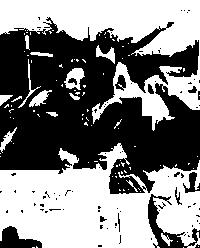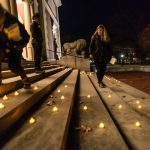 Before Bowdoin senior Sarah Glaser left to study in Ghana the fall of 2010, she had the foresight to apply for a Bowdoin grant that would help her establish a business while she was abroad.
Before Bowdoin senior Sarah Glaser left to study in Ghana the fall of 2010, she had the foresight to apply for a Bowdoin grant that would help her establish a business while she was abroad.
She applied for and was granted the Thomas Andrew McKinley ’06 Entrepreneur Grant, which provided her $5,000 to live in Ghana and set up African Art Stands, an import/export nonprofit. She spent the spring semester making contacts with artists, collecting art, and shipping the pieces back to Alaska, her home state, where she planned to sell them at galleries.
The name African Art Stands refers to a scene common in Ghana where many artists gather to sell their work alongside roads. “Fifty people or so line up their work in a roadside market,” Glaser described, “and the art is priced low. There’s lots of local talent and very few connections to markets that are strong.”
Glaser said she also liked the name because “it was neutral and didn’t play of pitying emotions,” and it “positively displayed the creativity of that region.”
By the end of her time in Ghana, Glaser had set up partnerships with five painters and five craftspeople whose work she thought would appeal to American buyers. She purchased paintings for a down payment of $100 each, “a better price than they’d get in Ghana,” as well as smaller crafts. If the work went on to sell in the United States, she gave the artists money from the sale, minus a 20 percent or 30 percent cut for the gallery and shipping and handling costs.
Because Glaser was supported by a grant, she didn’t earn money from her first-year transactions. But she says going forward, she will figure out a fair wage to pay herself.
Last year, she brought back 22 paintings from Ghana for three art galleries in Seward, Alaska, and three elsewhere, where roughly half of them sold. The highest-priced painting, by artist Robert Amin, went for $600, and some of the artists also earned commissions to paint more. Glaser says the artists priced their own works.
The crafts she sold, such as beads and Trashy Bags’ painted recycled sachets – which hold drinking water in Ghana – tended to be popular and helped Glaser recoup some of her costs. (Glaser worked at Trashy Bags during her first semester in Ghana, helping the company recycle the sachets into bags and wallets and stopping them from becoming yet more litter on the streets.)
The paintings retailed for a total of just over $7,000 and the crafts for just under $8,000, including quilted aprons and bags, woven baskets, recycled plastic bags and gifts, beaded jewelry and change purses. Over half of the proceeds went directly to the artists, according to Glaser.
“I wanted to do something that would fund itself, and do so in a way that the people it was helping would profit,” she said. “Plus, such beautiful art should be out in the world, and the people making it should be benefiting from it being out in the world.”
This summer – the selling season Alaska – Glaser says she will commission more Ghanaian paintings for the galleries in Seward. She also wants to expand to galleries in Anchorage. Now that she’s gained a better sense of the market, she anticipates she’ll have more sales. “Paintings of non-African things are more popular, because people can relate to them,” she said.
African Art Stands won’t be Glaser’s only venture. Besides importing art, she’ll work as a forest ranger in Alaska this summer and work part-time at one of the art galleries in Seward. Next fall, she plans to earn a pipe and structural welding degree from a vocational school and also set up, with her sister, an artist cooperative in Moose Pass, where Glaser is from. She envisions the co-op as a place that can foster people’s creativity without any one person having to invest a lot upfront in a studio or studio equipment. And it could help local people earn an income.
“Making art with other people is a lot of fun, and a community-building endeavor,” Glaser said, “and it is a viable way to make money.”
To see the artwork, go to africanartstands.wordpress.com.


